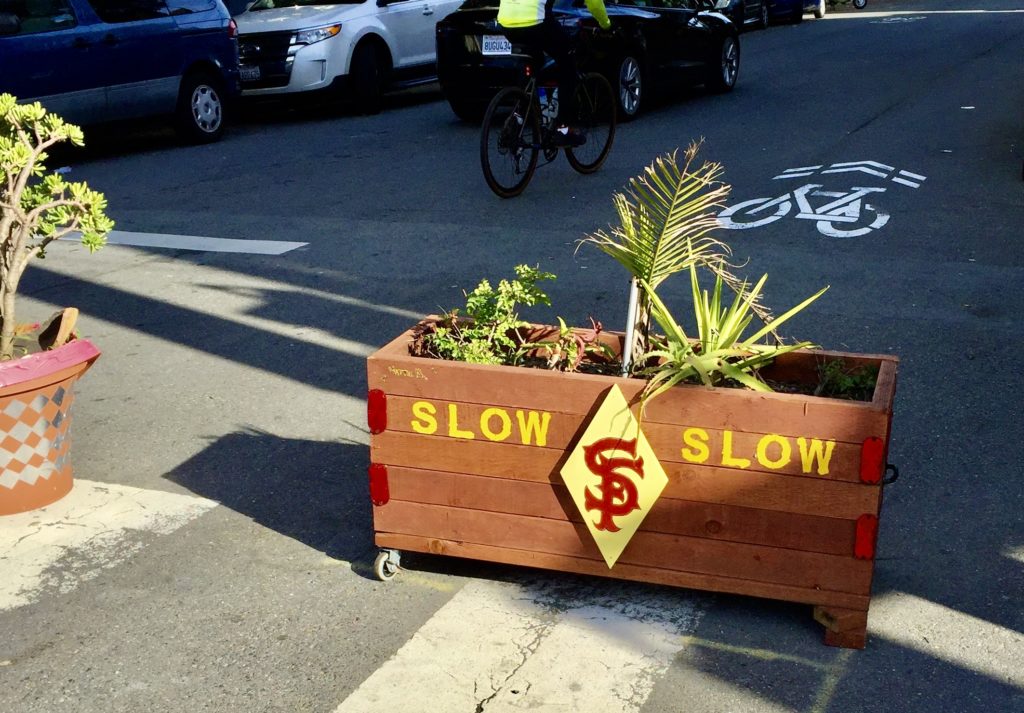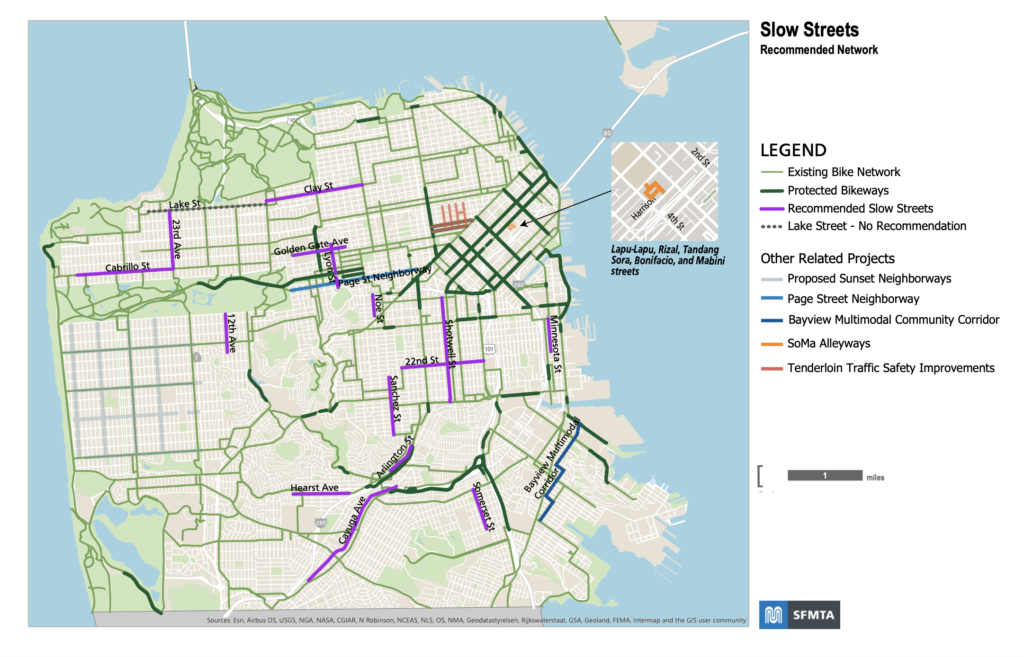Slow Streets have made San Francisco more livable. Let’s help make them permanent!

San Francisco’s Slow Streets, created over the past two and a half years, provide safe, low-stress ways for people to move around the city on foot and on bikes. Slow Streets quickly proved popular with residents, as demonstrated in online surveys conducted by SFMTA, and in the ways neighbors have embraced them – embellishing the traffic calming elements with art and planters, organizing community events, and so on.
San Francisco’s Slow Streets were created under the State’s pandemic emergency order, in consultation with neighborhood stakeholders. SFMTA staff have worked with neighbors to incrementally expand the temporary network, and to install better traffic safety devices. Other cities created their own slow streets to enhance mobility, provide for healthy outdoor recreation, and help neighborhood commercial districts survive the pandemic. Last year the state adopted AB 773 to give cities greater authority to designate slow streets and adopt effective traffic calming measures.
On Tuesday December 6, the SFMTA Board of Directors will decide whether to make Slow Streets permanent, and which streets to include in, or eliminate from, the permanent network.
For months Livable City has been working with a coalition of citywide organizations and neighborhood representatives to develop a People’s Slow Streets proposal, which we shared with SFMTA leadership. Our proposal has several key elements:
- Make the existing Slow Streets network permanent, continue to improve them in collaboration with neighbors, and support community stewardship of Slow Streets.
- Adopt strong design and performance standards for Slow Streets, including metrics (maximum traffic speeds and volumes) and a robust infrastructure toolkit that includes traffic-calming features, signage, gateways (like raised crosswalks) at major intersections, and placemaking – art, design, and landscape elements expressive of the community.
- Commit SFMTA to extending and expanding the network, to grow a connected network with particular attention, outreach, and resources to finding solutions that work for equity communities.
SFMTA staff’s proposal, released today, is a start. It recommends a permanent Slow Streets program, which will:
“Develop low-stress streets that provide active transportation connections within neighborhoods and enhance the City’s recommended bikeway network with a focus on improving residential streets by calming vehicle traffic, making them easier to navigate, and friendlier for walking and biking.
Thirteen existing Slow Streets – 12th Avenue, 23rd Avenue, Arlington Street, Cabrillo Street, Clay Street, Golden Gate Avenue, Hearst Avenue, Lyon Street, Minnesota Street, Noe Street, Sanchez Street, Shotwell Street, and Somerset Street – are recommended for permanence. An additional two corridors, Cayuga Avenue and 22nd Street, which were vetted but not implemented under the emergency program, would be added to the permanent network.
Streets in the network will get permanent infrastructure, including signage and delineator posts at intersections and mid-block speed humps. Slow Streets will have performance standards – a maximum of 1,500 autos per day and a maximum observed traffic speed of 20 mph or less. Streets which don’t meet these criteria will get additional traffic-calming treatments to bring speed and traffic to acceptable levels. We’re pleased that SFMTA has adopted criteria, but think their recommended speed and traffic volumes are too high to ensure safety. So fr
Several current Slow Streets are not recommended for permanence in the staff proposal. Lake Street is neither recommended nor not recommended. Lake is supported by a majority of neighbors, and forms a central connection what is now the longest continuous Slow Street corridor (Cabrillo – 23rd Ave – Lake – Clay). We strongly support including Lake Street in the permanent network, and are urging SFMTA’s board to do so next week. Several SoMa streets – Lapu Lapu, Rizal, Tandang Sora, Bonafacio, and Mabini – form a small interconnected network, and are popular with residents. However SFMTA staff propose not designating these as Slow Streets, but keeping the traffic calming features on these streets. Their argument that they’re not connected to other Slow Streets. This proposal creates an unnecessarily ambiguous situation for these streets, and we recommend adding them to the permanent Slow Streets network. MTA staff proposes removing another four streets – 20th Street, Chenery Street, Lombard Street, and Pacific Avenue – from the network, and removing the traffic calming features as well. Neighbors have been rallying behind 20th and Chenery, and we support keeping them in the network rather than eliminating them next week.
MTA is committing to expanding the network, and using its authority under AB 773 to expand the Slow Streets infrastructure toolkit. No details of the permanent program are proposed for adoption on December 7, but will be brought back to the SFMTA board at a future meeting. We will keep advocating for a robust and well-resourced Slow Streets program.
There are several ways to add your voice to the Slow Streets conversation. You can write a letter to the SFMTA board using this convenient letter-writing tool, or email them directly at MTABoard@SFMTA.com. You can attend the hearing, either in person or virtually, and speak in person or over the phone. Meeting info is here.

